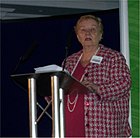| |||||||||||||||||||||||||||||||||||||||||
| |||||||||||||||||||||||||||||||||||||||||
| |||||||||||||||||||||||||||||||||||||||||
A deputy leadership election for the Labour Party in the United Kingdom took place on 2 October 1983 to replace incumbent Deputy Leader Denis Healey. Healey had served in the position since 1980, becoming deputy leader at the same time that Michael Foot became party leader. Foot and Healey had both announced their resignations following the general election on 9 June 1983, in which a disastrous performance left the Labour Party with just 209 seats in parliament.
The election was conducted using the Labour party's electoral college. It was won by Roy Hattersley, who won more than two-thirds of the votes. On the same day, Neil Kinnock won the leadership election. A young Peter Mandelson was employed in Hattersley's campaign team for the deputy leadership contest.
The election took place at Labour Party conference, with affiliated trade unions holding 40% of the votes, delegates from Constituency Labour Parties holding 30% of the votes, and the Parliamentary Labour Party holding the final 30% of the votes.
Candidates
- Denzil Davies, Shadow Secretary of State for Wales, Member of Parliament for Llanelli
- Gwyneth Dunwoody, Shadow Secretary of State for Health, Member of Parliament for Crewe and Nantwich
- Roy Hattersley, Shadow Home Secretary, Member of Parliament for Birmingham Sparkbrook
- Michael Meacher, former Under-Secretary of State for Trade, Member of Parliament for Oldham West
Result
| Candidate | Affiliated block votes (40%) |
CLP block votes (30%) |
PLP votes (30%) |
Overall result | |||||
|---|---|---|---|---|---|---|---|---|---|
| Votes | % | Votes | % | Votes | % | % | |||
| Roy Hattersley |
5,349 | 88.2 | 318 | 51.0 | 112 | 55.7 | 67.3 | ||
| Michael Meacher | 718 | 11.8 | 298 | 47.8 | 59 | 29.4 | 27.9 | ||
| Denzil Davies | 0 | 0.0 | 5 | 0.8 | 22 | 10.9 | 3.5 | ||
| Gwyneth Dunwoody | 0 | 0.0 | 2 | 0.3 | 8 | 4.0 | 1.3 | ||
See also
References
- Pointer, Graham (11 May 2015). "Should Tony Benn Have Been The Winner Of The 1981 Labour Deputy Leadership Election?". Graham Pointer's Blog. Retrieved 17 January 2016.
- Under the rules at the time of the contest, block votes were cast by delegates and the Parliamentary Party at Labour Party Conference. Affiliated Unions held 40% of the votes, CLPs 30% and the PLP 30%.
Sources
- Butler, David & Butler, Gareth (2006). British political facts since 1979 (p. 55). Basingstoke: Palgrave Macmillan. ISBN 978-1-4039-0372-3
- http://privatewww.essex.ac.uk/~tquinn/labour_party_deputy.htm Archived 17 April 2014 at the Wayback Machine
This United Kingdom election-related article is a stub. You can help Misplaced Pages by expanding it. |


